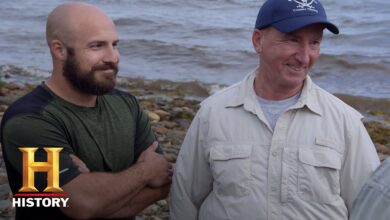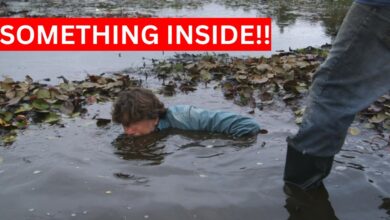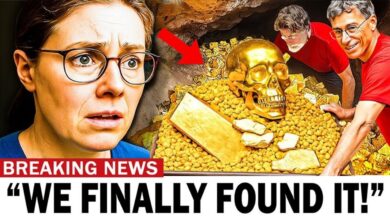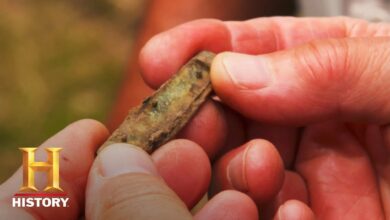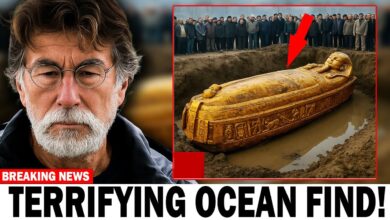1700s Intricate Button HIDDEN in Stone (Season 12) | The Curse of Oak Island
1700s Intricate Button HIDDEN in Stone (Season 12) | The Curse of Oak Island

On Lot 5, located
on the western side of the island…
FIONA: This test pit area
has been a conundrum to us.
We really felt
that there was something
that we were gonna discover
at this level
and we haven’t yet.
…Rick Lagina and
metal detection expert
Gary Drayton join
archaeologist Fiona Steele
and other members of the team
to assist
with the investigation of
a mysterious stone foundation.
FIONA: We haven’t
totally given up on this.
So we would really like to see
if you wouldn’t mind
doing a check, too.
-All right.
-RICK: In fact, Gary, if you’d
-wander everywhere,
just in case, right?
-GARY: Yep. Yep.
NARRATOR:
Over the past two years,
this stone structure
has yielded numerous clues
that suggest it may be
directly connected
to the Oak Island mystery.
(beeping)
In the wall?
-Yeah. In the wall,
you’ve got some iron there.
-FIONA: Okay.
NARRATOR:
These discoveries
include 17th-century
trade beads,
a mortar-like material
that matches soil samples
from more than 100 feet deep
in the Money Pit area
and iron tools
that have been scientifically
linked to Sir William Phips,
the 17th-century
English politician
who some believe conspired
with a high-ranking Freemason
named Andrew Belcher
to bury a vast cache
of Spanish silver and gold
on Oak Island
back in 1687.
FIONA:
We’re coming over, Moya,
-to do a scan of your pit.
-MOYA: Okay.
NARRATOR:
Now, since the feature
has been deemed
a “special place” by
the government of Nova Scotia,
Gary is allowed to detect
potential metal targets.
However, the archaeological
team must then slowly
and methodically
work to uncover them.
RICK:
The Lot 5 feature, though it has
expanded two to three times
its original appearance,
it’s still
not completely exposed
and to do it properly,
you have
to have a lot of patience.
And that’s fine,
that’s the process.
Yep, I’m getting iron.
I’ll get out of the way.
GARY:
Bigger piece of iron there.
Iron.
There’s iron all over
in this one.
Iron.
Cor blimey.
FIONA:
You guys are going to be busy.
(louder beeping)
-RICK: That’s different.
-(Gary chuckles)
-Non-ferrous!
-(laughter)
Yeah. That is non-ferrous.
-Oh!
-Okay. We’ll remember that.
GARY:
There’s a good chance
that’s a coin.
NARRATOR:
A non-ferrous target?
Indicating that something
potentially composed
of precious metals
is buried in the feature?
If so, could it mean
that this structure
was used to hide
something of great value?
GARY:
I’m telling you now,
there’s only three metals
that really make that sound.
It’s gonna be
copper, lead or gold.
You’ve got some great things
-waiting for you there.
-FIONA: Mm-hmm.
Well, we’ll keep excavating
and maybe when we get further
into it and have
this pit almost complete,
-we can call you back
for that again.
-HELEN: We’ll find it.
-We’ll call you, you have to come
down and do your gold dance.
-(Rick laughs)
-GARY: Okay. I will do that.
Can’t wait to see
what you dig up.
RICK:
Yep. Let’s hope for the gold.
RICK:
Yep. Let’s hope for the gold.
Later that afternoon…
JACK:
I like to just
kind of push it around.
NARRATOR:
…back on Lot 5,
located on the western
side of the island,
Craig Tester and Laird Niven
have joined Jack Begley
and other members of the team,
as they continue investigating
the rounded foundation
and nearby test pit
where Gary Drayton identified
a non-ferrous target
just one day ago.
JACK:
Oh, I think I found it.
-JACK: The metal hit?
-Yeah.
(blows)
-CRAIG: Oh, yeah.
-JACK: Oh…
LAIRD:
It’s looking like a button.
It’s got a pretty big
eye on there.
-CRAIG: Yeah, it sure does.
-JACK: Mm-hmm.
Does it have
designs on it? (gasps)
LAIRD:
It’s odd. It’s got, like, a rim.
CRAIG:
Yeah.
LAIRD:
That is a weird-looking button.
JACK:
Oh, jeez, Laird,
I bet you there’s something
on the… on the face of that.
-You definitely see
some sort of design there.
-JACK: Yeah.
LAIRD:
Almost floral?
From first glance, with
that green, it’s copper alloy.
-Mm-hmm.
-Mm-hmm.
Have you ever seen a button
that looked like that?
Honestly, no. I haven’t.
Wow.
NARRATOR:
An ornate, copper button?
Could it be
another important clue
that might help determine
who created this feature,
as well as the brick structure
in the swamp,
and perhaps even the Money Pit?
LAIRD:
But the beauty of
having the CT,
and even the XRF,
if that’s a design,
Emma can bring it out.
It’s certainly corroded
enough to be fairly old.
Well, good find.
That’s for sure.
JACK:
With it being so unique,
I’m hoping there’s
a real deep story
in just who might have made it
and how it made its way
to the island.
-Yeah, for sure.
-Fingers crossed.
-Well, we’ll get back after it.
-LAIRD: All right.
-Well, we’ll get back after it.
-LAIRD: All right.
The following morning…
RICK:
I can’t even imagine
how many times we’ve come into
the lab here to talk about
an artifact from Lot 5.
And that little button
is quite unique.
NARRATOR: …Rick Lagina,
Craig Tester
and other members of the team
join Laird Niven
and archaeometallurgist
Emma Culligan
in the Oak Island lab.
Laird, you certainly
have to speak to it.
NARRATOR:
They are eager to hear
Emma’s scientific analysis
of the mysterious button
that was unearthed
just one day ago,
near the rounded stone
foundation on Lot 5.
So, when I uncovered the button,
I thought it was just
a plain button back
until Emma showed me something
quite different and,
I think, quite unique.
-Mm.
-All right.
Come on, let’s see.
NARRATOR:
X-ray fluorescence mapping
uses highly concentrated
X-ray radiation
to assign colors
to the individual elements
on the surface of artifacts.
The process creates
a two-dimensional image
that further highlights
an object’s finer details,
but can also help to determine
when it may have been created.
Oh… my God.
GARY:
That is one fancy button.
LAIRD:
Mm-hmm.
What is that design?
Can you tell?
-Is that a flower?
-It’s a flower
and there’s
an intricate flower inside.
So, you see these
different little petals?
JACK:
Oh, wow.
GARY:
It’s got
an English-y feel to it.
It looks like
it could be an English button.
LAIRD:
Yeah.
EMMA:
You see
the little petals and how…
GARY:
Yeah.
EMMA:
…they’re formed there?
-That’s a really pretty button.
-Yeah, it sure is.
JACK:
So, what are
the speculative dates?
Safe bet would be 1700s
and then possibly…
-Yeah.
-…earlier.
GARY:
I think there’s
a good chance this button
could go in the late 1600s,
by the look of it.
Yeah.
It’s relatively small, so I
would say it’s not from a coat.
It’s relatively small, so I
would say it’s not from a coat.
Mm-hmm.
What do you think, Gary?
I think it’s too big
to be a cuff button.
I think it’s a jacket button–
fancy jacket button, as well.
To me, it looks like there’s
a design on the outer ring.
LAIRD:
T-That’s what
I was noticing as well, yeah.
GARY:
It’s just really worn, isn’t it?
-JACK: It’s super ornate.
-EMMA: Yeah.
If this button
dates to the 1600s,
that fits really well
with Sir William Phips.
NARRATOR:
In 1687,
King James II of England
ordered Sir William Phips
to conduct
two salvage operations
of the sunken
Spanish treasure galleon
known as the Concepcíon,
near the modern-day
Dominican Republic.
However,
Phips and his assistant,
Captain Andrew Belcher,
delivered less than half
of the silver and gold treasure
that was recorded
on the ship’s manifest.
We know that Phips
found silver on the Concepcíon.
And I believe
some of the treasure
from the Concepcíon
was secreted to Oak Island.
NARRATOR: According
to the theory
of 32nd-degree Freemason
Scott Clarke,
Phips and Belcher,
who was also
a high-ranking Freemason,
hid much of their
actual recovered valuables
on Oak Island.
I think there’s something
about this button
that might tell us
if it’s William Phips.
Yeah.
NARRATOR:
Could Jack be correct
that this button
might prove to be another clue
that supports this theory?
Just like the iron tools
found in the round feature
that have been scientifically
linked to William Phips?
Laird and the team
have spoke often
of how you believe
that the feature might be
considerably older
than we first thought.
This may be one of those points,
uh, to support that.
Yeah.
CRAIG:
Well, I mean,
I’m really excited.
What we have so far
sure is amazing, so…
-Love the flower design.
-LAIRD: Mm-hmm.
Yeah. It’s a blooming
lovely find.
(laughter)
-Just got to button this one up.
-(laughter)
So, having said that,
we need to go find more.
And we’ll leave the both of you
to try to come
to a further understanding
-of what that represents.
-Great.
-GARY: Great work.
-RICK: Thank you.
-CRAIG: Thank you.
-JACK: Thanks, Emma.
Thanks, Laird.




